Uttara Gogate1 and Jagdish Bakal2
1Thadomal Shahani Engineering College, Bandra, Mumbai, India.
2Shivajirao S. Jondhale College of Engineering, Dombivali (E), India.
Corresponding Author E-mail: uttara.gogate16@gmail.com
DOI : https://dx.doi.org/10.13005/bpj/1537
Abstract
Cardiovascular diseases (CVD) are the major cause of mortality globally, as well as in India. Most of the deaths caused by CVD are sudden and without giving any chance to provide any medical help. To avoid such impulsive accidental deaths precautions are always required. Due to this heart patients require continuous monitoring of certain vital body parameters such as heart rate, pulse rate and electrocardiogram (ECG) showing current health status clearly. In this paper we are presenting 3 - tier architecture of our prototype healthcare monitoring system using wireless sensor network (WSN) which is developed to continuously monitor certain body parameters of patient. Different biosensors available to measure heart rate, body oxygen level and temperature are attached to Arduino Nano board and recorded signals are sent to server using Node MCU ESP8266 wireless communication. Data is made available on remote servers for doctors and caregivers using ThingSpeak, an internet of things (IOT) application. In case of emergency caregivers can be notified using smart phone alerts. The system is useful for cardiac patients and can be used for infant or baby care and elderly care in home and hospitals. Accuracy of the system is found 95% with the response time of 10 seconds.
Keywords
Cardiac Patients; Cardiovascular Diseases; Healthcare Monitoring System; IOT; Wi-Fi; Wireless Sensor Networks
Download this article as:| Copy the following to cite this article: Gogate U, Bakal J. Healthcare Monitoring System Based on Wireless Sensor Network for Cardiac Patients. Biomed Pharmacol J 2018;11(3). |
| Copy the following to cite this URL: Gogate U, Bakal J. Healthcare Monitoring System Based on Wireless Sensor Network for Cardiac Patients. Biomed Pharmacol J 2018;11(3). Available from: http://biomedpharmajournal.org/?p=22231 |
Introduction
According to world health organization (WHO) analytics nearly 32% of adult deaths all over the world and also in India are due to cardiovascular diseases which are caused by disorders of the heart and blood vessels.1-4 These include various heart related diseases including coronary heart disease (heart attacks), rheumatic heart disease, raised blood pressure (hypertension), cerebrovascular disease (stroke), peripheral artery disease, congenital heart disease and heart failure.1 According to current estimates, India will soon have the highest number of heart disease cases in the world. These types of cardiovascular diseases need continuous monitoring of certain body parameters which need long hospital stays. In the hospitals patients are monitored continuously by hospital staff using various instruments like bedside monitors. These instruments are bulky and immobile and thus keep patients stick to the bed. Their wired connections are very uncomfortable to patients and medical staff also. Due to mounting hospital costs and shortage of qualified healthcare professionals it is difficult to continuously monitor the essential body parameters of the patients suffering from CVD.
In this paper, we introduce a health monitoring system consisting of a wearable device that will continuously monitor the health of patient. This wearable device consists of different sensors such as temperature sensor and heart rate sensor. The device will collect the data in form of bio signals from sensors and send it to hospital server for further storage and processing using wireless communication. This data will be available to the doctors on server from any location using IOT application.
This paper aims ultimately to build a health monitoring system for cardiac patients to monitor his/her vital body parameters especially related to heart problems like ECG and heart rate. We have made a prototype of an automated health monitoring system based on 3 – tier architecture of Wireless Body Area Network (WBAN) comprising various sensors for monitoring cardiac patients in ICU of hospital. In tier I, Arduino Nano board based on the ATmega328P microcontroller is used to collect data from sensors and send to server using ESP8266 Wi-Fi wireless communication in tier II. In tier III existing internet is used to send data to remote servers for further use over IOT application ThingSpeak.
The remaining paper is as follows. Section II describes some of the existing systems and shortcomings of those systems. Section III describes proposed system details. Results and conclusion are given in section IV and V respectively.
Literature Survey
In most of the hospitals health professionals use heart rate monitoring systems using manual methods to measure ECG by connecting lids to the chest of patient. The graph of ECG is monitored on the bedside monitor or special monitoring devices. These devices are wired and bulky and do not support long distance communication. The systems have many disadvantages like requirement of costly hospital stays which is not affordable for longer periods, needs expert monitoring and high cost maintenance.
Current advances lead to automation of heart rate and ECG measurement using different methods. Many authors have reviewed the state of art systems available for monitoring different vital body parameters like temperature, ECG, heart rate, pulse rate and galvanic skin response (GSR).5-7 Many researchers have contributed in automatic data collection of different signal from heart and detection of heart attack or emergencies related to other heart diseases using different methods. In8 authors proposed heart attack detection system using ZigBee heart rate monitoring and alert system. Many researchers have done extensive studies on use of mobile phones in healthcare and medical practices. This study illuminates the use of inbuilt applications like location enabled services of smartphones like GPS which is used for location monitoring of old age patient with instabilities.9-14 Apart from location tracking smart phones are used for health monitoring of cardiac patients.15 Many researchers proposed their methods using smart phones capable of detection, storage and analysis of collected records.
Much advancement can be done in these systems to make them more accurate, reliable, cost effective and wearable using biosensors. In hospitals and in homes cardiac patients can be monitored using healthcare monitoring system based on wireless sensor networks. The focus of our work is on continuous monitoring of cardiac patients in hospital especially in ICU and in homes using healthcare monitoring system based on wireless sensor networks. It achieves various goals like decrease in cost and long hospital stays; and continuous and remote monitoring without experts’ attendance is possible.18
Material and Methods
The proposed system is based on 3-tier wireless body area network (WBAN) architecture.16 3- tier architecture of WBAN is used in healthcare monitoring system comprising of different communication networks shown in fig 1. The detail explanation of components used in each tier of WABN is given in the block diagram of our proposed system Fig 2 which explains the construction of all the three tiers and the in between communications.
Proposed System Architecture
The proposed system architecture consists of three tiers. Tier-1 consists of wireless sensor nodes attached to the patient’s body for sensing vital body parameters. The data acquired through the sensors is processed and transmitted through control unit. Tier-2 is the intermediate receiving unit which acquires the forwarded data. It is also responsible for storage, processing and displaying the data. Tier-3 is concerned with alert systems and data transmission to longer distances through appropriate internet services. Different wireless communications such as ZigBee, Wi-Fi and Bluetooth are available for tier I, tier II and tier III communication.16 We are using existing Wi-Fi wireless communication in Tier I and II and internet in Tier III for long distance data transfer over IOT. The kind of communications taking place at each tier of the system is as shown in fig 1 and fig 2.
![Figure 1: Proposed 3-tier architecture of system [16].](https://biomedpharmajournal.org/wp-content/uploads/2018/09/Vol11No3_Hea_Utt_fig1-150x150.jpg) |
Figure 1: Proposed 3-tier architecture of system [16].
|
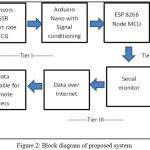 |
Figure 2: Block diagram of proposed system.
|
Proposed Methodology
We have designed and implemented a healthcare monitoring system for cardiac patients to monitor significant body parameters of patient inside hospital as well as in home. Different sensors are attached or induced to the patient’s body to collect vital body parameters like temperature, SPO2, heart rate, pulse rate etc. to be monitored. Heart rate and ECG sensor probes are also attached to patient’s body. The sensor data is in the form of analog signals and to be converted into digital form using inbuilt circuits of Arduino board which collects and processes sensor data for further communication. For further use and storage it is then send to server using suitable wireless communication. Fig 1 shows the 3-tier architecture of proposed system. In our proposed system ESP 8266 is used to convey sensor data to server using wireless communication. Existing Wi-Fi from home or hospitals is used for this purpose. After comparing different candidate wireless technologies16 we have chosen Wi-Fi for following main reasons:
Latest modules such as ESP 8266 are easy to connect and have built-in controller and Wi-Fi communication module.
As the system is used in ICU room, the room size considered for maximum of 8 beds in any hospital is nearly 2000 sq. meters,22,23 for which Wi-Fi is better than Bluetooth (Not enough range) or ZigBee (Low power hence cannot transmit for longer range).
Wi-Fi provides very high-speed access to internet compared to any other technology already established in the market. (Excluding Li-Fi which is not commercially available)
Data transmission rate of Wi-Fi is more i.e 1mbps compared to ZigBee which is 250 kbps.
Table 1: Comparison of candidate wireless technologies.
| ZigBee | Bluetooth | WiFi | |
| Maximum Range | 100m | 100m | 100m |
| Maximum power output | 1mW | 100mW | 500mW |
| Maximum Number of nodes | 240 | 32767 | 250 |
| Data transmission rate | 250 Kbps | 2.1 Mbps | 450 Mbps |
| Channel bandwidth | 5MHz | 902MHz | 160MHz |
In tier III, data from server is made available to authorized users from outside world using internet. We are using IOT application API ThingSpeak for this purpose. Using ThingSpeak cannels data is made available to authorized users like experts, doctors and caregivers who can remotely monitor patient’s data over internet and can get alert messages in any emergency situation. Block diagram of proposed system is shown in Fig 2.
Implementation Details
In this paper Arduino Nano is used to acquire readings from Max30100 heart rate sensor and send it over Wi-Fi using ESP8266. Inbuilt signal conditioning circuit is used for interfacing sensor with A to D converter of Arduino Nano. Signals are then send to cloud storage using Thing Speak. Thing Speak is an open source Internet of Things (IoT) application and API which is used to store and retrieve data from sensors and uses the HTTP protocol over the Internet or via a Local Area Network. Using Internet this medical data is made available to caregivers and doctors for reference. Existing Internet from home or hospital is used for this communication. An alert message is sent to caregivers and relatives when readings cross threshold values, considering an emergency. For increased complexity and accuracy ECG sensor AD 8232 is used which states the condition of heart correctly.18
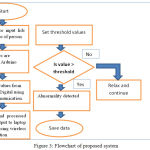 |
Figure 3: Flowchart of proposed system.
|
Results and Discussion
Data collected from sensors is sent over Thing Speak channels. Authorised users like caregivers and doctors with login and password can monitor this data. Fig 5 and Fig 6 shows the sample of results displayed on Thing Speak channels and Fig 7 shows results on monitor. Sample ECG signals are plotted in Fig.8.
Fig. 9 shows the packet loss recorded during transmission of data at different locations. Roughly 2% packet loss occurs in all transmissions regardless of of time and location. Fig 10 shows the histogram of communication range of Wi-Fi with respect to size of ICU room during 3 different experiments. Nearly equal sized ICU units at different locations and at different time are considered for above experimentations.
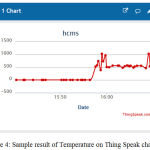 |
Figure 4: sample result of Temperature on Thing Speak channel.
|
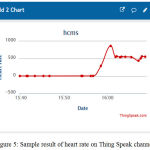 |
Figure 5: Sample result of heart rate on Thing Speak channel.
|
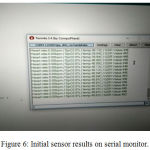 |
Figure 6: Initial sensor results on serial monitor.
|
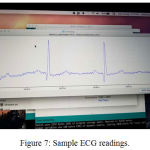 |
Figure 7: Sample ECG readings.
|
Feedback of the system on rating scale of 0-100 is obtained from patients who voluntarily participated in the survey is shown in Fig 13. 0 indicates total rejection and 100 indicate total acceptance. All responses below 50 rating are considered as rejected. The system is accepted by nearly 73% of subjects giving rating in the range of 70-100 with some suggestions regarding performance of the system.
Fig. 11 shows 24 hour’s data recording (nearly after 10 hours) of a patient. When our readings are validated with other heart rate measuring instruments like Fit Bit,19 95% accuracy is found. The response time of our system is found 10 seconds for ECG readings and 5 seconds for other body parameters.
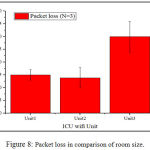 |
Figure 8: packet loss in comparison of room size.
|
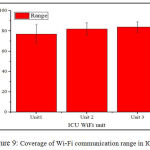 |
Figure 9: Coverage of Wi-Fi communication range in ICU
|
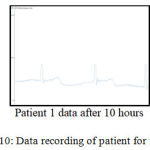 |
Figure 10: Data recording of patient for 24 hours.
|
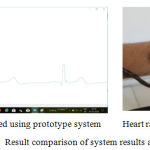 |
Figure 11: Result comparison of system results and FitBit results.
|
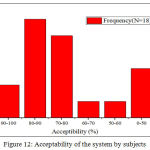 |
Figure 12: Acceptability of the system by subjects.
|
Conclusion
In this paper healthcare monitoring system for cardiac patients is proposed which monitors body parameters of heart patient like Heart rate, Temperature and SPO2. It helps caregivers and hospital staff to monitor and store patient’s body parameters continuously. On any abnormality, it gives alert to caregivers. Using Internet, data can be made available for remote use and only to authorized users like remote specialist doctors for special advice. Thus designing parameters like availability, security, correctness and efficiency are achieved successfully. Nearly 95% correct results are achieved when compared to standard clinical methods and commercial instruments like FitBit. Thus the system can found helpful for the continuous monitoring of the cardiac patients in ICU of hospitals. The use of this system can be extended to care and monitor elderly people staying all alone at their homes and also for baby care.
In future, the communication can be made collaborative by adding two way communication protocols for IOT so that doctors can monitor and advice patients online. Similarly, patients can ask there queries to remote doctors as well. Some more efforts are required to achieve 100% correctness in the system.
Acknowledgement
Author Uttara Gogate and Author Jagdish Bakal want to thank Dr. R. A. Marathe, Dr. H. M. Thakur and management and staff of M. D. Thakur memorial Hospital, Dombivli, Thane, MS. (India) for their help.
Conflict of Interest
There is no conflict of interest.
Funding Source
There is no funding source.
Informed Consent
Informed consent was obtained from all individual participants included in the study.
Ethical approval
Ethical approval is obtained from institute ethical committee of S. S. Jondhale C.O.E. Dombivli, India.
This article does not contain any studies with animals performed by any of the authors.
All procedures performed in studies involving human participants (whose written consents were obtained) were in accordance with the ethical standards of the institutional ethical research committee and with the accords comparable ethical standards of Indian medical council.
References
- http://www.searo.who.int/india/topics/cardiovascular_diseases.
- Global Atlas on Cardiovascular Disease Prevention and Control. World Health Organization in collaboration with the World Heart Federation and the World Stroke Organization. 3–18. ISBN 978-92-4-156437-3.
- Lancet Global regional and national age-sex specific all-cause and cause-specific mortality for 240 causes of death, 1990-2013: a systematic analysis for the Global Burden of Disease Study. 2013;385(9963):117–71. doi:10.1016/S0140-6736(14)61682-2.
CrossRef - Lancet Global regional and national life expectancy, all-cause mortality, and cause-specific mortality for 249 causes of death, 1980-2015: a systematic analysis for the Global Burden of Disease Study. 2015;388(10053):1459–1544. doi:10.1016/S0140-6736(16)31012-1.
CrossRef - Hande A and Ersoy C. Wireless sensor networks for healthcare: A survey. Computer networks. 2010;54(15):2688-2710.
CrossRef - Jeong K.G et al. Wireless sensor networks for healthcare. Proceedings of the IEEE. 2010;98(11):1947-1960.
CrossRef - Hung K and Zhang Y.T. Usage of Bluetooth/sup TM/in wireless sensors for Tele-healthcare., Engineering in Medicine and Biology, 2002. 24th Annual Conference and the Annual Fall Meeting of the Biomedical Engineering Society EMBS/BMES Conference, 2002. Proceedings of the Second Joint. IEEE. 2002;3.
- Ajitha U et.al. , IOT Based Heart Attack Detection and Alert System. IJEMR. ISSN (ONLINE). 2017;7(2):285-288. 2250-0758. ISSN (PRINT) 2394-6962.
- Fernando N.E. A Survey on Android Based Patient Monitoring System. GRD Journals Global Research and Development Journal for Engineering International Conference on Innovations in Engineering and Technology (ICIET). 2016.
- Naidu R. Android Based Healthcare Monitoring System, International Journal of Applied Sciences, Engineering and Management. 2016;5(1):98–100.
- Mutha N. Patient Health Monitoring Using Android Application. International Journal of Innovative Research in Computer And Communication Engineering. 2016;4(3).
- Maurya A. Design of a Wireless Health Monitoring System based on M2M Communication, International Conference on Control, Instrumentation, Communication and Computational Technologies (ICCICCT). 2014.
CrossRef - Zhou W. Family Medical Monitoring System Based on Embedded uC/OS-II and GPRS , Proceeding of the IEEE International Conference on Information and Automation Shenyang, China. 2015 .
- Zhang Y et al, Remote Mobile Health Monitoring System Based on Smart Phone and Browser Server Structure International Conference on Electronic Engineering and Computer Science. 2013.
- Gogate U., Marathe M., Mourya J., Mohan N. Android Based Health Monitoring System for Cardiac Patients. International Research Journal of Engineering and Technology (IRJET). 2017;4(4). e-ISSN: 2395 -0056 www.irjet.net p-ISSN: 2395-0072.
- Gogate U., Bakal J. Evaluation of performance parameters of Healthcare Monitoring System, ICIRTE, Mumbai, Special Issue of. IJIRCSE. 2018;5(3).
- Movassaghi S et al. Wireless Body Area Networks: A Survey. IEEE Communications surveys & tutorials. 2013 IEEE.
- Gogate U., Bakal J. Refining Healthcare Monitoring System Using Wireless Sensor Networks Based On Key Design Parameters. Information and Communication Technology for Intelligent Systems – Proceedings of ICTIS. 2018;1(2):6-7. Ahmadabad, India.
- https://www.fitbit.com
- Gogate U., Bakal J. Smart Healthcare Monitoring System Based on Wireless Sensor Networks. International Conference on Computing, Analytics and Security Trends (CAST 2016) at COEP, Pune. IEEE Explore. 2016;19-21. DOI: 10.1109/CAST.2016.7915037.
CrossRef - Nur N., Ayu F.,Che B.H. Health Care Monitoring Using Wireless Sensor Network (H-Caring), Thesis. 2012.
- ICU Planning and Designing in India – Guidelines 2010 by Guidelines Committee ISCCM, Dr Narendra Rungta (Convenor)
- Minimum standards for ICU to be adopted – www.hp.gov.in/dhsrhp/ICU.pdf.
- Dey N et al., Developing Residential Wireless Sensor Networks for ECG Healthcare Monitoring. IEEE Transactions on Consumer Electronics. 2017;63:4.
CrossRef - Elgendi M et. al, Improving Remote Health Monitoring:A Low-Complexity ECG Compression Approach. Diagnostics. doi:10.3390/diagnostics8010010 www.mdpi.com. journal diagnostics. 2018;8:10.
CrossRef - Arora J et al., Heartbeat Rate Monitoring System by Pulse Technique Using HB Sensor. ICICES 2014 – Chennai, Tamil Nadu, India, ISBN No.978-1-4799-3834-6/14/$31.00©.IEEE. 2014.
CrossRef - Jyh-How H. Design and Deployment of a Heart Rate Monitoring System in a Senior Center. Workshop on Design Challenges In Mobile Medical Device System. 978-1-4673-1905-8/13/. IEEE. 2013.
- LIU B et al. The Design of Portable ECG Health Monitoring System 2017 29th Chinese Control And Decision Conference (CCDC) 978-1-5090-4657-7/ IEEE. 2017.
- Kumar P.S et. al. On the Design of an Efficient Cardiac Health Monitoring System Through Combined Analysis of ECG and SCG Signals Sensors. 2018;18:379.








